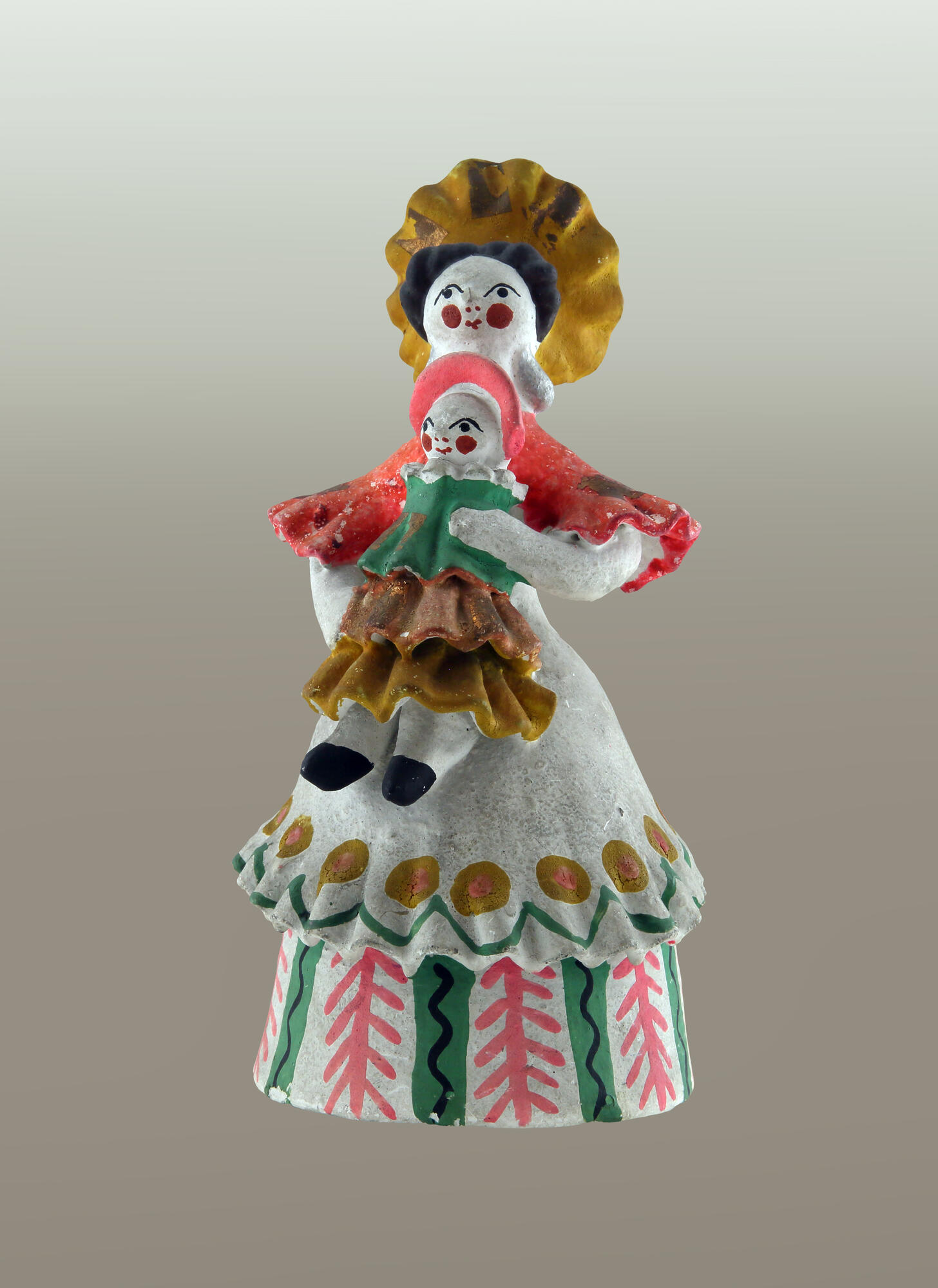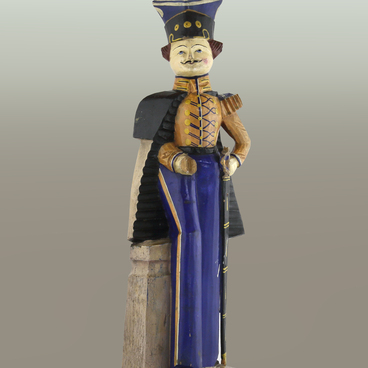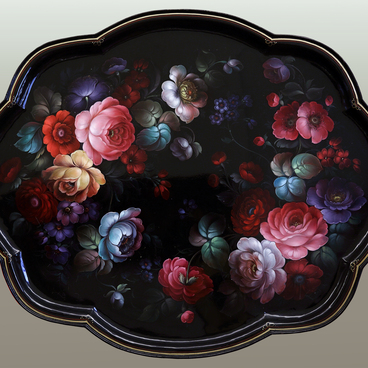The toy “Nanny with a Girl” was made by an experienced craftswoman of the Dymkovo toy, Elizaveta Alexandrovna Koshkina (1871–1953).
The characteristic features of Dymkovo clay toys developed back in the 19th century. The most traditional figurines of the Dymkovo trade were ladies in urban costumes, nannies and nurses with children in their arms, and water-carriers. When creating vivid images of townswomen, craftswomen developed a rich palette of expressive means of modeling and painting. The figurine “Nanny”, made by Elizaveta Koshkina, wears the usual clothes of nannies who worked in cities: a rounded skirt, a jacket, a snow-white ruffled apron and a high kokoshnik. Numerous stucco details of clothing are painted with bright colors of yellow, green, pink, orange, and decorated with pieces of Dutch gold — imitation of gold leaf. The figure has slender elongated proportions and looks especially statuesque.
Dymkovo is the most famous craft of clay toys in Russia. The birthplace of the Dymkovo toy is the provincial city of Vyatka (now Kirov). The craft got its name from the Dymkovo settlement near Vyatka, located on the other side of the river, where artisans made pottery and modeled toys. The craft developed due to the ancient local holiday called “Whistle”. In the 1880s, Dymkovo produced up to 100,000 toys a year. They were molded from local red clay, primed with chalk on milk, painted with dyes ground on eggs. Dymkovo toys could also serve as decoration in the everyday life of townspeople, instead of expensive porcelain figurines. Since the beginning of the 20th century, the craft has been in decline. Anna Afanasievna Mezrina (1853–1938) remained the only craftswoman. In the 1930s, with the active help of the artist Alexey Ivanovich Denshin, hereditary craftswomen Elizaveta Alexandrovna Koshkina and Evgenia Ivanovna Penkina resumed practicing the craft.
According to Alexey Denshin, Elizaveta Alexandrovna Koshkina has “a very special, own way of expressing herself in clay.” Her toys are distinguished by the richness of imagination, the splendor of coloring, the clarity and conciseness of forms. Koshkina created her own type of female images, that she used in all plots. Her female characters are smartly dressed. They wear clothes with alternating bright spots. Skirts and aprons are decorated with large patterns. The abundance of stucco details makes the figurines look more sophisticated, but does not deprive them of their calm balance. They are stately and majestic. They represent a certain standard of female beauty. Today, Dymkovo toys with their precious decorative painting are classified as small decorative sculptures.
The characteristic features of Dymkovo clay toys developed back in the 19th century. The most traditional figurines of the Dymkovo trade were ladies in urban costumes, nannies and nurses with children in their arms, and water-carriers. When creating vivid images of townswomen, craftswomen developed a rich palette of expressive means of modeling and painting. The figurine “Nanny”, made by Elizaveta Koshkina, wears the usual clothes of nannies who worked in cities: a rounded skirt, a jacket, a snow-white ruffled apron and a high kokoshnik. Numerous stucco details of clothing are painted with bright colors of yellow, green, pink, orange, and decorated with pieces of Dutch gold — imitation of gold leaf. The figure has slender elongated proportions and looks especially statuesque.
Dymkovo is the most famous craft of clay toys in Russia. The birthplace of the Dymkovo toy is the provincial city of Vyatka (now Kirov). The craft got its name from the Dymkovo settlement near Vyatka, located on the other side of the river, where artisans made pottery and modeled toys. The craft developed due to the ancient local holiday called “Whistle”. In the 1880s, Dymkovo produced up to 100,000 toys a year. They were molded from local red clay, primed with chalk on milk, painted with dyes ground on eggs. Dymkovo toys could also serve as decoration in the everyday life of townspeople, instead of expensive porcelain figurines. Since the beginning of the 20th century, the craft has been in decline. Anna Afanasievna Mezrina (1853–1938) remained the only craftswoman. In the 1930s, with the active help of the artist Alexey Ivanovich Denshin, hereditary craftswomen Elizaveta Alexandrovna Koshkina and Evgenia Ivanovna Penkina resumed practicing the craft.
According to Alexey Denshin, Elizaveta Alexandrovna Koshkina has “a very special, own way of expressing herself in clay.” Her toys are distinguished by the richness of imagination, the splendor of coloring, the clarity and conciseness of forms. Koshkina created her own type of female images, that she used in all plots. Her female characters are smartly dressed. They wear clothes with alternating bright spots. Skirts and aprons are decorated with large patterns. The abundance of stucco details makes the figurines look more sophisticated, but does not deprive them of their calm balance. They are stately and majestic. They represent a certain standard of female beauty. Today, Dymkovo toys with their precious decorative painting are classified as small decorative sculptures.



